Hoover Dam
Tunnels
To divert the river's flow around the construction site, four tunnels were driven through the canyon walls, two on the Nevada side and two on the Arizona side. These tunnels were to be 56 feet in diameter. Their combined length was nearly 16,000 feet (more than three miles).
Tunneling began at the lower portals of the Nevada tunnels in May 1931. Shortly after, work began on two similar tunnels in the Arizona canyon wall.
The work presented great difficulties. Initially, there were no roads into the canyon, so all of the workers and equipment had to be brought in by boat. In time, roads were built into the canyon, and catwalks were strung across the river, so that the workmen could ride to work in trucks.
It was extremely hot that summer and the temperatures in the workings reached 140o F (60o C). When winter arrived, icy winds whipped through the canyon as temperatures dropped to freezing.
At one point in September 1932, work had to be abandoned and the site evacuated as flood waters swept through the canyon.
Holes for explosive had to be bored into the rock using pneumatic drills. Five hundred pneumatic drills, hoses and compressors were purchased from Ingersall Rand. Compressor plants were installed just below the outlet portals, near the Arizona adit, and upstream by the inlet portals. Compressed air was taken to the work sites through a network of pipes 2" to 6" in diameter.
 To speed the work of drilling the holes, a
"drilling jumbo" was constructed on the back of an old ten-ton truck. The jumbo
was backed up to the working face and from 24 to 30 drills went to work,
drilling powder holes into the rock. This jumbo allowed half of the tunnel face
to be worked on and all of the holes drilled at once. When the holes were
finished, the jumbo moved to the other side of the face and began drilling the
other side of the face, while the finished holes were packed with powder and
wired. When both sides were drilled, the jumbo was removed. A total of eight of
these jumbos were constructed.
To speed the work of drilling the holes, a
"drilling jumbo" was constructed on the back of an old ten-ton truck. The jumbo
was backed up to the working face and from 24 to 30 drills went to work,
drilling powder holes into the rock. This jumbo allowed half of the tunnel face
to be worked on and all of the holes drilled at once. When the holes were
finished, the jumbo moved to the other side of the face and began drilling the
other side of the face, while the finished holes were packed with powder and
wired. When both sides were drilled, the jumbo was removed. A total of eight of
these jumbos were constructed.
The holes were filled with dynamite, and the rock broken up by the explosions. A ton of dynamite was used for every 14 feet of tunnel dug.
Once a shot had been fired, expert miners inspected the tunnel for safety, then crews moved in and mucked out the broken rock with power shovels and hand tools. Several conveyor belt type mucking machines were used to speed the work. The broken rock was loaded into dump trucks and hauled down river where it was dumped into great spoil dumps in the side canyons. To eliminate the need to turn trucks around in the limited space available, the trucks were backed down into the canyon. Ultimately, more than 1,500,000 cu. yd. of spoil were removed from the tunnels.
 In March 1932, work began on lining the tunnels
with concrete. First the base or invert was poured. Gantry cranes, running on
rails through the entire tunnels were used to place the concrete. The sidewalls
were poured next. Moveable sections of steel form were used for the sidewalls.
Finally, using pneumatic guns, the overheads were filled in. The concrete lining
is 3 feet thick, reducing the finished tunnel diameter to 50 ft.
In March 1932, work began on lining the tunnels
with concrete. First the base or invert was poured. Gantry cranes, running on
rails through the entire tunnels were used to place the concrete. The sidewalls
were poured next. Moveable sections of steel form were used for the sidewalls.
Finally, using pneumatic guns, the overheads were filled in. The concrete lining
is 3 feet thick, reducing the finished tunnel diameter to 50 ft.
In November 1932, a barrier across the inlets of the Arizona tunnels was breached with explosives. Earth and rock were dumped from a trestle bridge to block the river channel, forcing the entire flow of water into the tunnels.
For nearly two years, the Colorado river flowed unchecked through the diversion tunnels. In the fall of 1934, this all changed. Cofferdams were built at the entrances to tunnels 2 and 3, those closest to the river. Concrete plugs 405 feet thick were dovetailed into the tunnels, closing the bores forever.
As winter low water approached, another cofferdam closed off tunnel number 1. When this tunnel was plugged, 4 six-foot diameter holes were left in the plug, each fitted with a gate valve.
On February 1, 1935, a huge steel gate weighing more than 1000 tons was lowered over the entrance to tunnel # 4. By opening the valves in plug #1, sufficient water to meet downstream needs was released while the waters of the Colorado river began to back up behind Hoover Dam to form Lake Mead. For the first time in history, the Colorado River was under man's control.
Source - U.S. Department of the Interior - Bureau of Reclamation